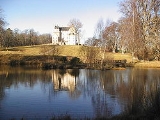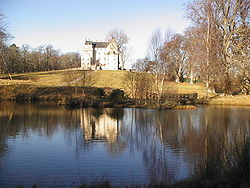
Castle Grant
Encyclopedia

Grantown-on-Spey
Grantown-on-Spey is a town in the Highland Council Area in Scotland.It was founded in 1765 as a planned settlement on a low plateau at Freuchie beside the river Spey at the northern edge of the Cairngorm mountains, about 20 miles South East of Inverness .It is the main town in what was the...
and was the former seat of the Clan Grant
Clan Grant
-Origins:The Grants are one of the clans of Siol Alpin, and descend from the 9th century Kenneth MacAlpin, King of Scots; and also of Norse origin, from settlers who are the descents of Haakon inn Riki Sigurdarsson , Jarl of Hladr, Protector of Norway ,-Origins:The Grants are one of the clans of...
chiefs of Strathspey in Moray
Moray
Moray is one of the 32 council areas of Scotland. It lies in the north-east of the country, with coastline on the Moray Firth, and borders the council areas of Aberdeenshire and Highland.- History :...
.
History
The original tower was built in the 14th century by the Clan Comyn of Badenoch. Originally a Comyn Clan stronghold, clan traditions tell us that the castle was taken from the Comyns by a combined force of the Clan GrantClan Grant
-Origins:The Grants are one of the clans of Siol Alpin, and descend from the 9th century Kenneth MacAlpin, King of Scots; and also of Norse origin, from settlers who are the descents of Haakon inn Riki Sigurdarsson , Jarl of Hladr, Protector of Norway ,-Origins:The Grants are one of the clans of...
and the Clan MacGregor
Clan MacGregor
Clan Gregor, Clan McGregor, Clan MacGregor or Clan M'Gregor is a Highland Scottish clan. It is the most senior clan of Siol Alpin, translated as referring to King Kenneth I, descending from the ancient Kings of the Picts and Dál Riata...
. The Grants and MacGregors stormed the castle and in the process slew the Comyn Chief - and kept the Chief's skull as a trophy of this victory. The skull of the Comyn was taken as a macabre trophy and was kept in Castle Grant and became an heirloom of the Clan Grant. (In the late Lord Strathspey's book on the Clan, he mentions that the top of the cranium was hinged, and that he saw documents kept in it.) Clan tradition predicts grave things if the skull ever leaves the hands of the family - prophesying that the Clan would lose all of its lands in Strathspey.
According to "Castles of Scotland", the original building was a Z-shaped tower house, typical of many that exist in Scotland from the same period, and it probably dates from the 15th century.
Previously named Castle Freuchie, it became the principal residence of the Grants in 1693. Clan Grant, like many Highland clans, had divided loyalties regarding the monarchy, and the castle was occupied by Jacobites
Jacobitism
Jacobitism was the political movement in Britain dedicated to the restoration of the Stuart kings to the thrones of England, Scotland, later the Kingdom of Great Britain, and the Kingdom of Ireland...
during both the 1715 and 1745 Jacobite Risings.
When "The Good Sir James" Grant (Chief from 1773–1811) set about his plans to build the town that would become "Grantown-on-Spey
Grantown-on-Spey
Grantown-on-Spey is a town in the Highland Council Area in Scotland.It was founded in 1765 as a planned settlement on a low plateau at Freuchie beside the river Spey at the northern edge of the Cairngorm mountains, about 20 miles South East of Inverness .It is the main town in what was the...
", there were no masons of sufficient skill to be employed in Strathspey. Sir James set up a training school for local men at Castle Grant and the modern appearance of the north face of Castle Grant is the result
In the 1750s a massive classical extension designed by John Adam was added to the north aspect. The result reminded Queen Victoria on her visit in 1860 of a factory.
The original L-shaped tower was extended in 1765 by Sir Ludovic Grant, into the castle which remains today. The castle eventually fell into disrepair but was refurbished in the 1990s and is now a private residence.
From the south side, the origins of the castle are still evident with the four-story 15th century Comyn Tower. The impressive Grant collection of weapons, which were once housed in the castle, are now on view at Fort George. A Category A listed building, Castle Grant is now under refurbishment.
The castle contains dozens of rooms, one of which is a massive dining hall. While the south face of the Castle with its two extended wings protruding from it, and its large stone staircase and courtyard, make it appear to be the "front" of the castle (the side it is most often photographed from), it is actually the back! The main door in the courtyard, which looks like the front door, actually leads from the back down a long hall to the front of the castle.
Lord Strathspey described a visit to Castle Grant in 1919 "We were taken around by Colonel Grant Smith, the Strathspey 'estate factor' who had collected us from the Grant Arms hotel where we were staying. The castle entrance hall and walls were covered with weapons of all types - cannons, muskets, guns,pistols, claymores, broad swords, armour and saddle furniture, sporting guns, blunderbuss
Blunderbuss
The blunderbuss is a muzzle-loading firearm with a short, large caliber barrel, which is flared at the muzzle and frequently throughout the entire bore, and used with shot and other projectiles of relevant quantity and/or caliber. The blunderbuss could be considered to be an early form of shotgun,...
es, rifles, pikes, and targes, etc. Many of these were the weapons provided by Sir James Grant for his 'Company of Fencibles', which he raised with his own money in 1793, in support of King George III, when a Napoleonic invasion was threatened. The armoury and the uniforms which were stored in the attics were considered to be one of the greatest and most unusual private collections existing. Hanging from the ceiling on the stair wells were a number of very old flags sewn on netting to keep them together. Leaning on a right hand stair-post was a length of timber about the size of a short railway sleeper. I was told that this was the laird's 'hanging beam', used when Grant was a regality. On the first floor in the left wing were the drawing room and the library, and at the back, stretching across the castle, was the dining-room. All the walls were, of course, hung with a great many portraits of the Chief's family and of other Grants. In the drawing room I saw the Comyn's skull on a writing desk. Nearby, at the end of the room, was the Byfield organ, 15 ft. high and 7 ft. wide, which had been given to Sir James Grant by Queen Anne, together with some special glass dishes, as a token for his agreeing to give up the name and arms of Colquhoun of Luss."
During the late 20th century the castle became derelict. Dry rot had spread throughout the wooden timbers in the upper floors and attic. The late Lord Strathspey (the father of the current Chief) speculated that when soldiers were quartered in the castle in the 1940's, during World War II
World War II
World War II, or the Second World War , was a global conflict lasting from 1939 to 1945, involving most of the world's nations—including all of the great powers—eventually forming two opposing military alliances: the Allies and the Axis...
, that the repeated mopping of the floors (one assumes like "swabbing the deck" - a military exercise in order and cleanliness), and the constant moisture from this activity in the wood, caused a terrible dry rot to set into the timbers, which slowly demolished the upper floors of the building. It seems that many of the castles in Scotland
Scotland
Scotland is a country that is part of the United Kingdom. Occupying the northern third of the island of Great Britain, it shares a border with England to the south and is bounded by the North Sea to the east, the Atlantic Ocean to the north and west, and the North Channel and Irish Sea to the...
that housed troops during this period suffered similar problems.
The castle went through a series of owners, and in the late 1990s started to be renovated. The castle is now owned by Scottish entrepreneur Craig Whyte
Craig Whyte
Craig Whyte is a Scottish businessman and the owner of Rangers Football Club.Whyte first entered business in a plant hire company; since then he has branched out into security, manufacturing and property, before becoming a venture capitalist...
. A major refurbishment project was completed at a cost of £5 million and the castle is now a private home.

